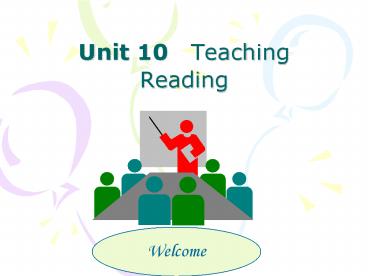Unit 10 Teaching Reading - PowerPoint PPT Presentation
1 / 19
Title:
Unit 10 Teaching Reading
Description:
Usually, there are two ways to read, reading aloud and silent reading which are ... concentrate on the important bits, skim the rest, and skip the insignificant parts; ... – PowerPoint PPT presentation
Number of Views:112
Avg rating:3.0/5.0
Title: Unit 10 Teaching Reading
1
Unit 10 Teaching Reading
Welcome
2
Teaching Objectives
- 1.The purpose of learning to read
- 2.The ways to read
- 3.The things people read
- 4.The skills involved in reading
- 5.The principles for teaching reading
- 6.Common types of activities in teaching reading.
3
I. The purpose of learning to read
- Reading is a very important skill for ESL
learning - Reading is an input skill
- Reading can help students to master other skills.
4
II. The ways to read
- Usually, there are two ways to read, reading
aloud and silent reading which are different in
many aspects. Obviously, reading aloud cannot
replace silent reading as it involves only the
skills of pronunciation and intonation, while
ones real reading ability requires the reading
skills of skimming, scanning, predicting, etc.
5
II. The ways to read
- Effective readers do the following
- 1.They have a clear purpose in reading
- 2.They read silently
- 3.They read phrase by phrase, rather than word by
word - 4.They concentrate on the important bits, skim
the rest, and skip the insignificant parts - 5.They use different speeds and strategies for
different reading tasks - 6.They perceive the information in the target
language rather than mentally translate - 7.They guess the meaning of new words from the
context, or ignore them - 8.They have and use background information to
help understand the text.
6
III. The things people read
- ESL/EFL textbooks have a heavy load of literary
texts (e.g. stories, tales) and non-literary
passages (e.g. essays, diaries, anecdotes,
biographies). Besides authentic texts, ESL/EFL
textbooks also employ a lot of non-authentic
texts, i.e. simulated texts. Though appearing
authentic, these materials are written especially
for language students with some - language control.
7
IV. Skills involved in reading comprehension
- In order to achieve the two levels of reading,
the reader needs the following skills - Recognising the script of a language
- Understanding the explicitly stated
information, conceptual meaning, the
communicative value (functions) of sentences - Deducing the meaning of unfamiliar lexical
items - Understanding relations within sentences,
relations between sentences, references
8
IV. Skills involved in reading comprehension
- Recognising indicators in discourse, the
organization of the text - Making inferences.
- In order to make reading more efficient, students
also need the following strategic skills - Distinguishing the main idea from supporting
details - Skimming reading for the gist or main idea
- Scanning reading to look for specific
information - Predicting guessing what is coming next.
9
V. Principles and models for teaching reading
- Some principles for teaching reading
- Tasks should be clearly given in advance.
Preferably, tasks should motivate students. - Tasks should be designed to encourage selective
and intelligent reading for the main meaning
rather than test the students understanding of
trivial details. - Tasks should help develop students reading
skills rather than test their reading
comprehension. - Teachers should help the students to read on
their own.
10
V. Principles and models for teaching reading
- Two models for teaching reading
- 1.Bottom-up model
- 2.Top-down model
- Three stages
- pre-reading, while-reading, and post-reading.
11
VI. Pre-reading activities
- 1. Predicting
- --Predicting based on the title
- --Predicting based on vocabulary
- --Predicting based on the T/F questions.
- 2. Setting the scene
- 3. Skimming
- 4. Scanning
12
VII. While-reading activities
- 1. Information transfer activities
- Focus attention on the main meaning of the
text. - Be able to simplify sophisticated input so that
is becomes the basis for output. - Allow students to perform tasks while they are
reading. - Highlight the main structural organization of a
textlpart of a text, and show how the structure
relates to meaning.
13
VII. While-reading activities
- Involve all the students on clearly defined
reading tasks. - Precede one step at a time (i.e. students
should do easier tasks before doing more
complicated ones). - When a TD task is completed, provide students
with a model for oral and for written work.
14
VII. While-reading activities
- 2. Reading comprehension questions
- 1) Questions for literal comprehension.
- 2) Questions involving reorganization or
reinterpretation. - 3) Questions for inferences.
- 4) Questions for evaluation or appreciation.
- 5) Questions for personal response.
15
VII. While-reading activities
- 3. Understanding references
- Sometimes students have difficulty with
certain texts because they are unable to follow
clearly the use of references. All natural
language, spoken or written, uses referential
words such as pronouns to refer to people or
things already mentioned previously in the
context. Understanding what these words refer to
is crucial for comprehension.
16
VII. While-reading activities
- 4. Making inferences
- Making inferences, which means reading
between the lines, is an important reading
skill. It requires the reader to use background
knowledge in order to infer the implied meaning
of the author.
17
VIII. Post-reading Activities
- 1. Discussion
- 2. Role-play
- 3. Gap-filling
- 4. Retelling
- 5. False summary
- 6. Writing
18
IX. Assignments
- 1.Read Chapter 5 of TLEBC.
- 2.Do all the exercises in the text.
- 3.Prepare a 5 minutes Reading Class.
19
Thank you ! Good bye !































